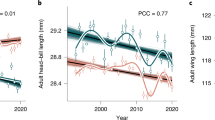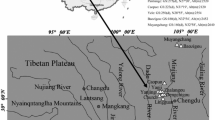Abstract
Animals that exhibit indeterminate growth obey such a functional relationship: adult body size = f (initial size + growth rate × age). Using this framework, we investigated how and why body sizes of a toad species (Bufo andrewsi) covaried across six altitudes (760–2,100 m) in western China. Towards high altitudes, toads tended to produce large eggs, attain large sizes at metamorphism and have great average age, but grow slowly. This indicated that the former three variables contributed more to the observed altitudinal increase in body size than did the last one. The altitudinal variation in these life-history traits should be adaptive to increased climate harshness and decreased predation risks at higher altitudes. We suggest that the relative significance of responses of these size-related parameters to local environments may provide critical cues to explaining considerable variability in geographic size pattern among ectothermic vertebrates.




Similar content being viewed by others
References
Adams DC, Church JO (2008) Amphibians do not follow Bergmann’s rule. Evolution 62:413–420
Altwegg R, Reyer HU (2003) Patterns of natural selection on size at metamorphosis in water frogs. Evolution 57:872–882
Angilletta MJ, Steury TD, Sears MW (2004) Temperature, growth rate, and body size in ectotherms: fitting pieces of a life-history puzzle. Integr Comp Biol 44:498–509
Ashton KG (2002) Do amphibians follow Bergmann’s rule? Can J Zool 80:708–716
Ashton KG, Feldman CR (2003) Bergmann’s rule in nonavian reptiles: turtles follow it, lizards and snakes reverse it. Evolution 57:1151–1163
Atkinson D (1994) Temperature and organism size—a biological law for ectotherms? Adv Ecol Res 25:1–58
Atkinson D, Sibly RM (1997) Why are organisms usually bigger in colder environments? Making sense of a life history puzzle. Trends Ecol Evol 12:235–239
Beck E, Kottke I, Bendix J, Makeschin F, Mosandl R (2008) Gradients in a tropical mountain ecosystem—a synthesis. In: Beck E, Bendix J, Kottke I, Makeschin F, Mosandl R (eds). Gradients in a tropical mountain ecosystem of Ecuador. Ecol Stu 198: 451–463
Bergmann C (1847) Über die verhältnisse der warmeökonomie der thiere zuihrer grosse. Gottinger Studien 1:595–708
Berven KA, Gill DE, Smith-Gill SJ (1979) Countergradient selection in the green frog, Rana clamitans. Evolution 33:609–623
Brown HA (1990) Morphological variation and age-class determination in overwintering tadpoles of the tailed frog, Ascaphus truei. J Zool Lond 220:171–184
Chen XH, Yang J, Qiao L, Zhang LX, Lu X (2011) Reproductive ecology of the stream-dwelling frog Feirana taihangnicus in central China. Herpetol J 21:135–140
Cummins CP (1986) Temporal and spatial variation in egg size and fecundity in Rana temporaria. J Anim Ecol 55:303–316
Cvetković D, Tomašević N, Ficetola GF, Crnobrnja-Isailović J, Miaud C (2009) Bergmann’s rule in amphibians: combining demographic and ecological parameters to explain body size variation among populations in the common toad Bufo bufo. J Zool Syst Evol Res 47:171–180
Dziminski MA, Vercoe PE, Roberts JD (2009) Variable offspring provisioning and fitness: a direct test in the field. Funct Ecol 23:164–171
Eaton BR, Paszkowski CA, Kristensen K, Hiltz M (2005) Life-history variation among populations of Canadian toads in Alberta, Canada. Can J Zool 83:1421–1430
Ficetola GF, Scali S, Denoël M, Montanaro G, Vukov TD, Zuffi MAL, Padoa-Schioppa E (2010) Ecogeographical variation of body size in amphibians: comparing the hypotheses using the newt Triturus carnifex. Global Ecol Biogeogr 19:485–495
Gillespie GR (2011) Life history variation in the spotted tree frog, Litoria spenceri (Anura: Hylidae), from southeastern Australia. Herpetologica 67:10–22
Haddon M (2001) Modelling and quantitative methods in fisheries. Chapman and Hall, Florida
Kaplan RH, King EG (1997) Egg size is a developmentally plastic trait: evidence from long-term studies in the frog Bombina orientalis. Herpetologica 53:149–165
Kozłowski J, Czarnołeski M, Dańko M (2004) Can optimal resource allocation models explain why ectotherms grow larger in cold? Integr Comp Biol 44:480–493
Lai YC, Lee TH, Kam YC (2005) A skeletochronological study on a subtropical, riparian ranid (Rana swinhoana) from different elevations in Taiwan. Zool Sci 22:653–658
Laugen AT, Laurila A, Räsänen K, Merilä J (2003) Latitudinal countergradient variation in the common frog ( Rana temporaria) developmental rates–evidence for local adaptation. J Evol Biol 16:996–1005
Laugen AT, Laurila A, Jönsson KI, Söderman F, Merilä J (2005) Do common frogs (Rana temporaria) follow Bergmann’s rule? Evol Ecol Res 7:717–731
Laurila A, Pakkasmaa S, Merilä J (2001) Influence of seasonal time constraints on growth and development of common frog tadpoles: a photoperiod experiment. Oikos 95:451–460
Leclair R Jr, Laurin G (1996) Growth and body size in two populations of mink frogs Rana serpentrionalis from two latitudes. Ecography 19:296–304
Lessard JP, Sackett TE, Reynolds WN, Fowler DA, Sanders NJ (2010) Determinants of the detrital arthropod community structure: the effects of temperature, resources, and environmental gradients. Oikos 120:333–343
Liao WB, Lu X (2009) Male mate choice in the Andrew’s toad Bufo andrewsi: a preference for larger females. J Ethol 27:413–417
Liao WB, Lu X (2010a) A skeletochronological estimation of age and body size by the Sichuan torrent frog (Amolops mantzorum) between two populations at different altitudes. Anim Biol 60:479–489
Liao WB, Lu X (2010b) Age structure and body size of the Chuanxi tree frog Hyla annectans chuanxiensis from two different elevations in Sichuan (China). Zool Anz 248:255–263
Liao WB, Zhou CQ, Yang ZS, Hu JC, Lu X (2010) Age, size and growth in two populations of the dark-spotted frog Rana nigromaculata at different altitudes in southwestern China. Herpetol J 20:77–82
Lu X, Li B, Liang JJ (2006) Comparative demography of a temperate anuran, Rana chensinensis, along a relatively fine altitudinal gradient. Can J Zool 84:1789–1795
Ma XY, Lu X (2009) Sexual size dimorphism in relation to age and growth based on skeletochronological analysis in a Tibetan frog. Amphibia-Reptilia 30:351–359
Ma XY, Lu X, Merilä J (2009a) Altitudinal decline of body size in a Tibetan frog Nanorana parkeri. J Zool Lond 279:364–371
Ma XY, Tong LN, Lu X (2009b) Variation of body size, age structure and growth of a temperate frog, Rana chensinensis, over an altitudinal gradient in northern China. Amphibia-Reptilia 30:111–117
Marangoni F, Tejedo M (2008) Variation in body size and metamorphic traits of Iberian spadefoot toads over a short geographic distance. J Zool Lond 275:97–105
Matthews KR, Miaud C (2007) A skeletochronological study of the age structure, growth, and longevity of the mountain yellow-legged frog, Rana muscosa, in the Sierra Nevada, California. Copeia 2007:986–993
Merilä J, Laurila A, Laugen AT, Räsänen K, Pahkala M (2000) Plasticity in age and size at metamorphosis in Rana temporaria–comparison of high and low latitude populations. Ecography 23:457–465
Morrison C, Hero JM (2003) Geographic variation in life-history characteristics of Amphibians: a review. J Anim Ecol 72:270–279
Morrison C, Hero JM, Browning J (2004) Altitudinal variation in the age at maturity, longevity, and reproductive lifespan of anurans in subtropical Queensland. Herpetologica 60:34–44
Olalla-Tárraga MA, Rodríguez MA (2007) Energy and interspecific body size patterns of amphibian faunas in Europe and North America: anurans follow Bergmann’s rule, urodeles its converse. Global Ecol Biogeogr 16:606–617
Palo JU, O’Hara RB, Laugen AT, Laurila A, Primmer CR, Merila J (2003) Latitudinal divergence of common frog (Rana temporaria) life history traits by natural selection: evidence from a comparison of molecular and quantitative genetic data. Mol Ecol 12:1963–1978
Pincheira-Donoso D, Hodgson DJ, Tregenza T (2008) The evolution of body size under environmental gradients in ectotherms: why should Bergmann’s rule apply to lizards? BMC Evol Biol 8:68
Roff DA (2002) Life history evolution. Sinauer Associates, Inc., Sunderland
Rozenblut B, Ogielska M (2005) Development and growth of long bones in European water frogs (Amphibia: Anura: Ranidae), with remarks on age determination. J Morphol 265:304–317
Ryser J (1996) Comparative life histories of a low- and a high-elevation population of the common frog Rana temporaria. Amphibia-Reptilia 17:183–195
Sagor ES, Ouellet M, Barten E (1998) Sleletochronology and geographic variation in age structure in the wood frog, Rana sylvatica. J Herpetol 32:469–474
Sinsch U, Marangoni F, Oromí N, Leskovar C, Sanuy D, Tejedo M (2010) Proximate mechanisms determining size variability in natterjack toads. J Zool Lond 281:272–281
Turbill C, Bieber C, Ruf T (2011) Hibernation is associated with increased survival and the evolution of slow life histories among mammals. Proc Roy Soc Lond B (in press)
von Bertalanffy L (1938) A quantitative theory of organic growth. Hum Biol 10:181–213
Wallace RL, Diller LV (1998) Length of the larval cycle of Ascaphus truei in coastal streams of the redwood region, northern California. J Herpetol 32:404–409
Wells KD (1977) The social behaviour of anuran amphibians. Anim Behav 25:666–693
Wells KD (2007) The ecology and behavior of amphibians. University of Chicago Press, Chicago
Williams PD, Day T, Fletcher Q, Rowe L (2006) The shaping of senescence in the wild. Trends Ecol Evol 21:458–463
Acknowledgments
We thank B.Q. Yang, X.Z. Jing and T.L. Yu for assistance during the field work. We are thankful for Dr. L. X. Zhang and two anonymous referees for their comments on the manuscript. Financial support of this study is provided by National Sciences Foundation of China (30425036).
Author information
Authors and Affiliations
Corresponding author
Rights and permissions
About this article
Cite this article
Liao, W., Lu, X. Adult body size = f (initial size + growth rate × age): explaining the proximate cause of Bergman’s cline in a toad along altitudinal gradients. Evol Ecol 26, 579–590 (2012). https://doi.org/10.1007/s10682-011-9501-y
Received:
Accepted:
Published:
Issue Date:
DOI: https://doi.org/10.1007/s10682-011-9501-y




